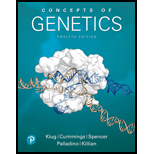
With the initial appearance of the feature we call “Now Solve This,” a short introduction is in order. The feature occurs several times in this and all ensuing chapters, each time providing a problem related to the discussion just presented. A “Hint” is then offered that may help you solve the problem. Here is the first problem:
- (a) If an organism has a diploid number of 16, how many chromatids are visible at the end of mitotic prophase?
- (b) How many chromosomes are moving to each pole during anaphase of mitosis?
(a)
To determine: The number of chromatids that are visible at the end of prophase stage of mitosis.
Introduction: Mitosis is a process of division in which two daughter cells produce, and each daughter cell has the same complement of chromosomes as the parent cell.
Explanation of Solution
Prophase is the first stage of mitosis. In this stage, chromatin fibers start to condense, and nuclear envelope disappears, and centrioles divide. As chromatin fibers condense, the thread-like structures, the chromosomes, become visible.
It becomes apparent near the end of prophase that each chromosome consists of two parts, which are called sister chromatids. For example, if an organism has diploid number of 16 chromosomes, 32 chromatids would be visible at the end of mitotic prophase.
(b)
To determine: The number of chromosomes that move towards the opposite poles during anaphase.
Introduction: Mitosis is divided into several stages: prophase, prometaphase, metaphase, anaphase, and telophase.
Explanation of Solution
In metaphase, the homologous chromosomes duplicate. Anaphase is the shortest stage of mitosis. The events critical to chromosome distribution occur during this stage. In this stage, sister chromatids of each chromosome disjoin from one other and are pulled towards opposite ends. This event is described as disjunction. If an organism has a diploid number of 16 chromosomes, 16 chromosomes will move towards the opposite poles during anaphase.
Want to see more full solutions like this?
Chapter 2 Solutions
Concepts of Genetics (12th Edition)
Additional Science Textbook Solutions
Microbiology: An Introduction
Organic Chemistry (8th Edition)
Chemistry: An Introduction to General, Organic, and Biological Chemistry (13th Edition)
Physics for Scientists and Engineers: A Strategic Approach, Vol. 1 (Chs 1-21) (4th Edition)
Campbell Biology (11th Edition)
Applications and Investigations in Earth Science (9th Edition)
- Not part of a graded assignment, from a past midtermarrow_forwardNoggin mutation: The mouse, one of the phenotypic consequences of Noggin mutationis mispatterning of the spinal cord, in the posterior region of the mouse embryo, suchthat in the hindlimb region the more ventral fates are lost, and the dorsal Pax3 domain isexpanded. (this experiment is not in the lectures).a. Hypothesis for why: What would be your hypothesis for why the ventral fatesare lost and dorsal fates expanded? Include in your answer the words notochord,BMP, SHH and either (or both of) surface ectoderm or lateral plate mesodermarrow_forwardNot part of a graded assignment, from a past midtermarrow_forward
- Explain in a flowcharts organazing the words down below: genetics Chromosomes Inheritance DNA & Genes Mutations Proteinsarrow_forwardplease helparrow_forwardWhat does the heavy dark line along collecting duct tell us about water reabsorption in this individual at this time? What does the heavy dark line along collecting duct tell us about ADH secretion in this individual at this time?arrow_forward
 Biology Today and Tomorrow without Physiology (Mi...BiologyISBN:9781305117396Author:Cecie Starr, Christine Evers, Lisa StarrPublisher:Cengage Learning
Biology Today and Tomorrow without Physiology (Mi...BiologyISBN:9781305117396Author:Cecie Starr, Christine Evers, Lisa StarrPublisher:Cengage Learning Human Heredity: Principles and Issues (MindTap Co...BiologyISBN:9781305251052Author:Michael CummingsPublisher:Cengage Learning
Human Heredity: Principles and Issues (MindTap Co...BiologyISBN:9781305251052Author:Michael CummingsPublisher:Cengage Learning Concepts of BiologyBiologyISBN:9781938168116Author:Samantha Fowler, Rebecca Roush, James WisePublisher:OpenStax College
Concepts of BiologyBiologyISBN:9781938168116Author:Samantha Fowler, Rebecca Roush, James WisePublisher:OpenStax College Biology: The Dynamic Science (MindTap Course List)BiologyISBN:9781305389892Author:Peter J. Russell, Paul E. Hertz, Beverly McMillanPublisher:Cengage Learning
Biology: The Dynamic Science (MindTap Course List)BiologyISBN:9781305389892Author:Peter J. Russell, Paul E. Hertz, Beverly McMillanPublisher:Cengage Learning Human Biology (MindTap Course List)BiologyISBN:9781305112100Author:Cecie Starr, Beverly McMillanPublisher:Cengage Learning
Human Biology (MindTap Course List)BiologyISBN:9781305112100Author:Cecie Starr, Beverly McMillanPublisher:Cengage Learning Anatomy & PhysiologyBiologyISBN:9781938168130Author:Kelly A. Young, James A. Wise, Peter DeSaix, Dean H. Kruse, Brandon Poe, Eddie Johnson, Jody E. Johnson, Oksana Korol, J. Gordon Betts, Mark WomblePublisher:OpenStax College
Anatomy & PhysiologyBiologyISBN:9781938168130Author:Kelly A. Young, James A. Wise, Peter DeSaix, Dean H. Kruse, Brandon Poe, Eddie Johnson, Jody E. Johnson, Oksana Korol, J. Gordon Betts, Mark WomblePublisher:OpenStax College





